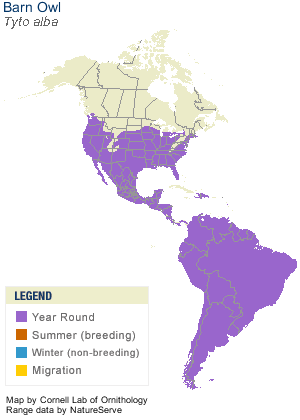Habitat
Tyto albas (or Barn Owls) prefer to live in large open spaces such as grasslands, marshes as well as farm fields. Many children traditionally draw owls living in hallowed out trees, this is actually one of Tyto ablbas most desired nesting spaces. They also prefer to roost in the top floors of abandoned buildings (like old barns), but they will nest in man made boxes as long as they are at the height of roughly two stories. Many birds like to use twigs or grass as building material for their nests. Tyto alba on the other hand favors using old owl pelts, which unfortunately tends to give their nesting sites a dirty appearance. These owls will return to their nest year after year, and they have no problem using a nest made by a different pair of Barn Owls. Tyto alba can be found almost all over the world, the exceptions are some parts of the West Indies, New Zealand as well as Indonesia. They are unable to withstand the extreme cold of the far northern continents. The individual niches of each Barn Owl fluctuates from owl to owl. This variation is most likely caused by the amount of food and resources available. But the typical range that each Tyto alba hunts can be anywhere from a little over half a square mile to well over 12 miles. The size of the range depends on how much food is present – the less there is the larger the range and the more abundant the food the smaller the range. Barn owls do not fight over hunting territories in fact they often overlap. [Barn Owl (Tyto alba), 2011]
Tyto alba is sometimes mobbed which is when several  smaller
birds gain up on another bird to drive it away. When
this occurs Tyto alba does not fight back like many
other predator birds will, they simply fly away
usually back to its nest. Occasionally other
predator birds such as corvids and diurnal birds mob
Tyto alba, but the Kestrel falcon is by far the
worst. It has been known to wait and watch for the
Barn Owl to leave its nest and in one case it
actually partially blinded or greatly harmed Tyto
alba. The Kestrel falcon has also been observed to
watch the Barn Owl hunt and then attack as soon as
the Barn Owl has captured its food and steal it.
Strangely enough though these two have been seen to
have a kind of truce. There are reports that they
shared the same floor of a barn and even raised
their young next to each other without killing one
another. [Bunn, 1982 ]
smaller
birds gain up on another bird to drive it away. When
this occurs Tyto alba does not fight back like many
other predator birds will, they simply fly away
usually back to its nest. Occasionally other
predator birds such as corvids and diurnal birds mob
Tyto alba, but the Kestrel falcon is by far the
worst. It has been known to wait and watch for the
Barn Owl to leave its nest and in one case it
actually partially blinded or greatly harmed Tyto
alba. The Kestrel falcon has also been observed to
watch the Barn Owl hunt and then attack as soon as
the Barn Owl has captured its food and steal it.
Strangely enough though these two have been seen to
have a kind of truce. There are reports that they
shared the same floor of a barn and even raised
their young next to each other without killing one
another. [Bunn, 1982 ]
For a look at where Barn Owls live, check out the virtual map:
http://ebird.org/ebird/map/brnowl?bmo=1&emo=12&byr=2009&eyr=2013
Return to Home page or continue to Adaptation